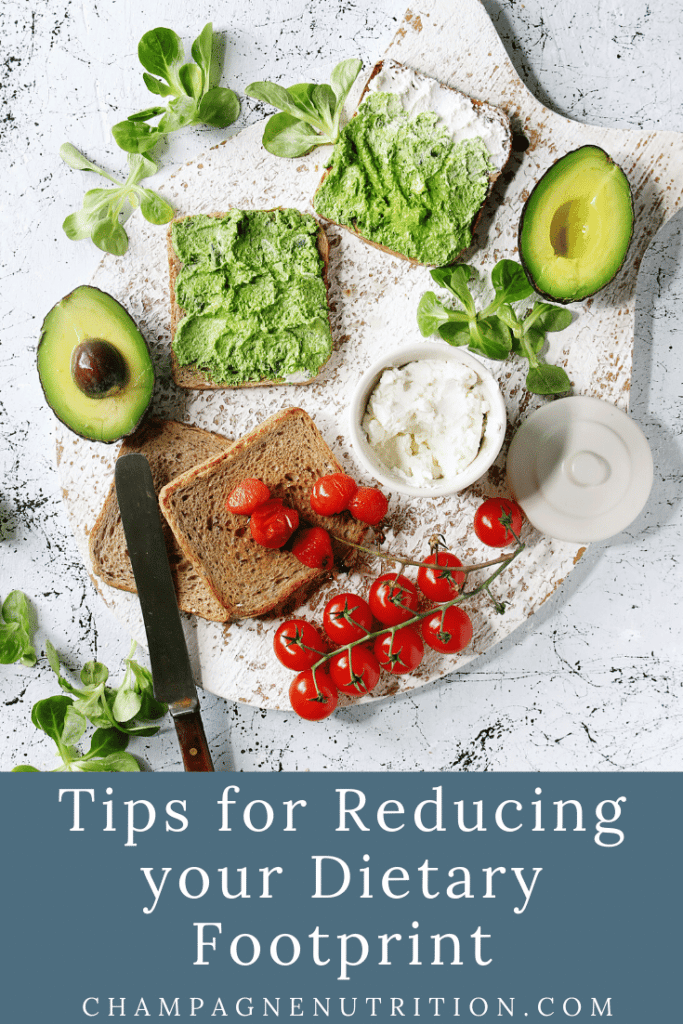Tips for Reducing your Dietary Footprint
July 23, 2015 by Ginger Hultin MS RDN
Nutrition and the environment: what is the connection? We talk about being sustainable…about going green or protecting the environment but are we doing enough and are we doing it the right way? I’m from Seattle and attended Bastyr University so I was lucky to get some training in this topic when I studied nutrition there. Since then, I’ve moved on to more clinical work but my great friend, fellow dietitian and PhD candidate, Chris Vogliano specializes in nutrition and the environment. He is the passionate expert behind Forward Eating. We met years ago when we worked closely together as leaders within the Vegetarian Nutrition Dietetic Practice Group which is part of our national Academy of Nutrition and Dietetics. He is guest blogging with me today and I hope that you find this piece as informative and critically important as I do – read on to learn more about practicing true sustainability and saving the environment, one bite at a time as he presents tips for reducing your dietary footprint.

“Going green” and “sustainability” are common buzzwords that have been trending in the media and sales pitches for years– and for good reason. The majority of the scientific community has come to a consensus that the climate is quickly changing. Our growing global economy, which relies heavily on fossil fuels to operate, is a significant contributor to the emission of greenhouse gasses that are linked to the rapid change of our Earth’s climate. According to the World Wildlife Foundation, we are currently using 1.5 Earth’s-worth of resources for our current population. The United Nations’ Food and Agriculture Organization (FAO) has projected that cropland and pasture-based food production will see a 60% increase over the next 30 years, which will increase stress on our valuable finite resources. Agriculture is the main driver of our loss of biodiversity and a major contributor to climate change and pollution, so further land expansion is undesirable. With our population expected to grow from 6.9 billion people in 2010, to 9.68 billion in 2050, we have to make some serious changes to help slow and reverse these negative effects. Agricultural innovations and technology are a crucial piece to helping efficiently feed the growing global population, but further actions are required if we want to create a sustainable food system.
So what does that have to do with my dinner?
Surprisingly, more than you might think. Agriculture accounts for a significant amount of fossil fuels, fresh water usage, and land degradation. While all foods have an environmental footprint, some foods score much higher on the spectrum (Figure 1). The most energy- intensive meals are those with large portions of animal protein, with beef being the highest. Animal protein is highly energy-intensive due to the massive feed requirements, water consumption, land usage, and transportation costs. For example, to produce one quarter pound hamburger patty, it requires 6.7 pounds of grain, 52.8 gallons of fresh water, and 74.5 square feet of land for grazing and growing crops. Global figures are not available, but in the United States, with the world’s fourth largest land area, livestock are responsible for an estimated 55 percent of erosion and sediment, 37 percent of pesticide use, 50 percent of antibiotic use, and a third of the loads of nitrogen and phosphorus into freshwater resources.
Agricultural practices currently consume 70% of the world’s fresh water usage to grow and produce the food we eat. The water footprint of meat increases from chicken meat (4,300 m3/ton), goat meat (5,500 m3/ton), pig meat (6,000 m3/ton) and sheep meat (10,400 m3/ton) to beef (15,400 m3/ ton). The differences can be partly explained from the different feed conversion efficiencies of the animals. Beef production, for example, requires 8 times more feed (in dry matter) per kilogram of meat compared to producing pig meat, and 11 times if compared to chicken meat. As demand for fresh, potable water and farmable land continues to rise, how we utilize our natural resources is of increasing importance.
What can I do to reduce my dietary footprint?
Two evidence-based methods that have been shown to reduce environmental impact while increasing food security are to focus on decreasing food waste and replacing our livestock-heavy protein sources with less energy-intensive protein options such as legumes and pulses. The 2013 Australian Dietary Guidelines recommend individual weekly meat consumption of no more than 455 g, or approximately 16 ounces. To compare, Americans are currently eating about 83 ounces per week, over five times the recommended consumption. Our high intake of animal-based proteins are taking a toll on our environment through deforestation and pollution, and in some cases our personal health.
Whether you are ready to commit to a fully vegetarian diet or simply ready to reduce the meat intake, eating nutrient-rich plant-based foods is a lifestyle that environmentalists and dietitians alike can agree on. The Academy of Nutrition and Dietetics takes an official stance on plant-based diets, stating that “appropriately planned vegetarian diets … are healthful, nutritionally adequate, and may provide health benefits in the prevention and treatment of certain diseases.” Bill Gates states our current animal consumption patterns are not sustainable and must change if we are going to feed 9 billion people by 2050. Plant-based diets filled with fruits, vegetables, legumes, and whole grains provide excellent sources of valuable nutrients and fiber, which over 90% of Americans are lacking in adequate amounts.
Many consumers and companies are making honest efforts to try and reduce our environmental footprint to help slow and reverse climate change. As food demands continue to grow, how we use our natural resources such as land and water will be critical to the sustainability of our environment. What you choose to put on your plate can have a direct impact on your health and the health of our planet.
Give it a try by supporting and promoting the environmental efforts of eating less meat, even if it’s just one day a week! You can save the environment one bite at a time, reducing your dietary footprint and improving your health as well.
Check out the resources below for more information on tips for reducing your dietary footprint and for how to have a balanced and healthy more plant-based diet:
50 Best Vegetarian Recipes (written by dietitians!)
Vegetarian Nutrition Practice Group
5 Comments
Leave a Comment

Ginger Hultin,MS, RD, CSO
Thanks for visiting! If you're struggling with a cancer diagnosis, autoimmune condition, gut health problems, or even a medical mystery, nutrition can make a HUGE difference in your day-to-day life. I run a virtual, concierge private practice where I partner with my clients over time to help them improve their health through nutrition. Be sure to visit the blog for easy, plant-based, anti-inflammatory recipes and our "Resources" page for a variety of self-paced programs, books, e-books, and nutrition podcast episodes.


Awesome article! Always a pleasure to read about this topic, one of my faves these days. Thank you!
You are such a leader in this space – I love how you’re weaving it into everything you do these days!
I find this article so very helpful as I just started learning more about diet or health. I also just started doing a diet so this article really interests me. Thanks!
Thanks! The power of diet is so amazing for health AND sustainability. Appreciate you stopping by